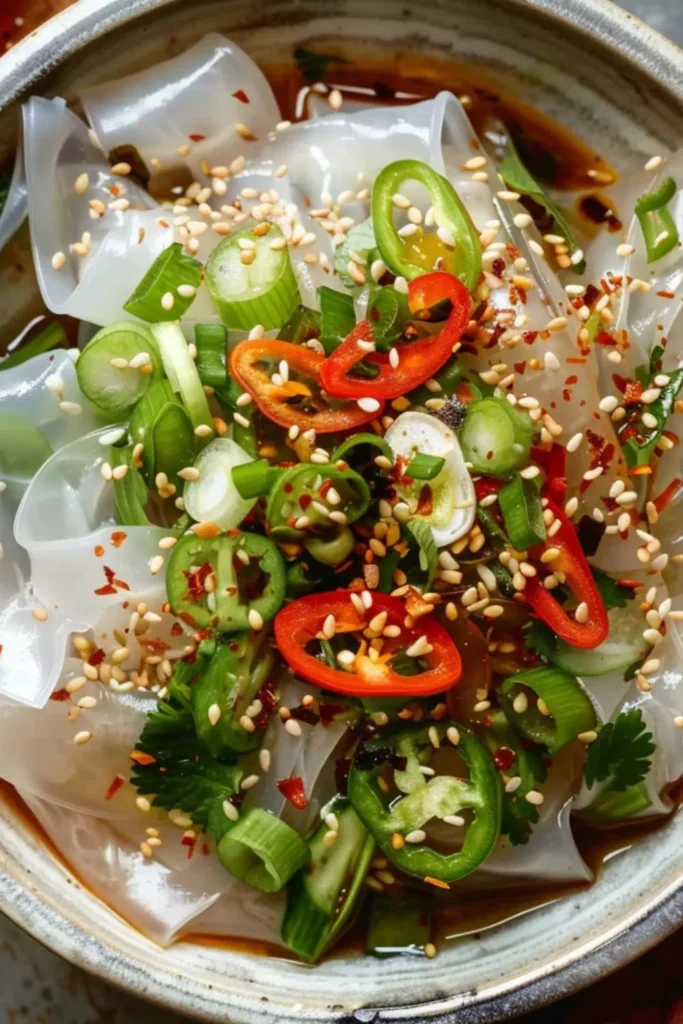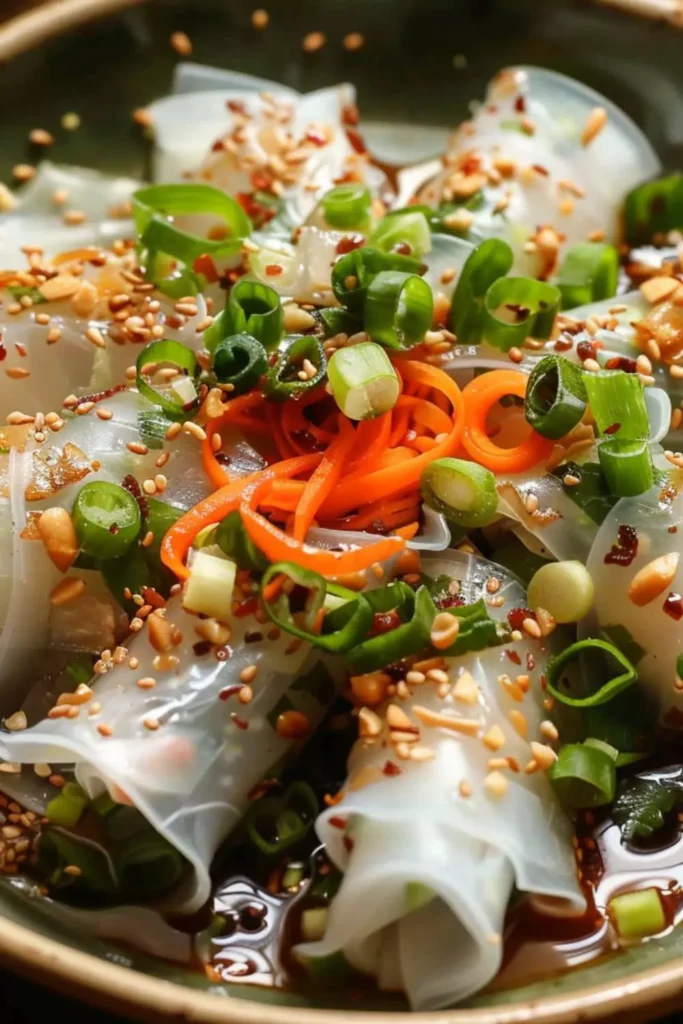As I sat down to enjoy a delicious meal with my family, a delightful aroma wafted through the air, signaling the arrival of one of our favorite dishes – rice paper noodles.
This dish has always held a special place in our hearts, not only because of its exquisite taste but also because of the memories and traditions associated with it.
Today, I am excited to share with you the story of rice paper noodles, a recipe that has been passed down through generations and continues to bring joy to our dinner table.

What Are Rice Paper Noodles?
Rice paper noodles, also known as rice vermicelli or rice sticks, are a type of thin noodle made from rice flour.
These translucent noodles are a popular ingredient in various Asian cuisines, including Vietnamese, Thai, and Chinese. They are often used in dishes like spring rolls, stir-fries, and soups, thanks to their light and delicate texture.
What Does It Taste Like?
Rice paper noodles have a neutral flavor, which allows them to absorb the taste of the other ingredients in the dish.
When cooked, they have a soft and slightly chewy texture that adds a satisfying bite to any recipe. The slight sweetness of the rice flour complements savory sauces and spices, creating a harmonious balance of flavors.
You’ll also like the following Dinner recipes!
- Cheesecake Factory Thai Lettuce Wraps Copycat Recipe
- How to make Optavia Lean and Green Cheeseburger Pie
- Houston’s Hawaiian Ribeye
Why This Recipe Works?
1. Versatile and Customizable: Rice paper noodles can be paired with a variety of ingredients, making them a versatile choice for different recipes.
2. Quick and Easy to Prepare: These noodles cook quickly, perfect for those busy weeknights when you need a satisfying meal in no time.
3. Light and Healthy: Rice paper noodles are low in calories and fat, making them a nutritious option for those looking to maintain a balanced diet.
4. Gluten-Free and Allergen Friendly: As they are made from rice flour, these noodles are suitable for those with gluten intolerance or allergies, offering a delicious alternative for a wide range of dietary restrictions.
Ingredients for Rice Paper Noodles:
Sauce:
– Garlic Clove: I use garlic to add a savory depth and aromatic flavor to the sauce, enhancing its overall taste.
– Sugar: It balances out the flavors in the sauce, providing a touch of sweetness to complement the other ingredients.
– Rice Vinegar: Rice vinegar adds a subtle tanginess to the sauce, balancing the richness of the other flavors.
– Aged Balsamic Vinegar: Aged balsamic vinegar infuses the sauce with a rich, complex sweetness and depth of flavor.
– Soy Sauce: I include soy sauce to provide a savory umami flavor and add depth to the sauce, enhancing its overall complexity.
Rice Paper Noodles:
– Scallion: I incorporate scallions for their fresh, mild onion flavor, enhancing the taste of the noodles.
– White Sesame Seeds: These seeds introduce a nutty flavor and crunchy texture to the noodles, enhancing their visual appeal and taste.
– Green Onion: Green onions contribute a subtle onion flavor and add color to the noodles, enhancing their overall presentation.
– Rice Paper Sheets: Rice paper sheets serve as the base for the noodles, providing a chewy texture and allowing for easy handling.
– Thai Red Chili Pepper or Gochugaru Flakes: I use these for a spicy kick, providing a burst of heat and flavor to the noodles.
– Avocado Oil: I drizzle avocado oil over the noodles for richness and flavor while preventing them from sticking together.
– Light Olive Oil: Light olive oil is used for its mild flavor and to complement the other ingredients in the recipe.

Step by Step Instructions
Creating Rice Paper Noodles:
Step 1: Prepare the Sauce
– Grate 2 small cloves of garlic into a small bowl.
– Add 1 teaspoon of sugar, 1 teaspoon of rice vinegar, 1 teaspoon of aged balsamic vinegar, and 1 tablespoon of soy sauce.
– Mix the ingredients well until they are thoroughly combined.
Step 2: Grease the Chopping Board
– Lightly coat a large chopping board with either avocado oil or light olive oil.
– Ensure the board is evenly coated to prevent the rice paper from sticking.
Step 3: Soak the Rice Paper Sheets
– Fill a large bowl with room temperature water.
– Take 3 rice paper sheets and stack them together.
– Submerge the stacked sheets in the water for about 10 seconds, ensuring they are fully covered.
– Lightly press down on the sheets to help them adhere and soften.
Step 4: Grease the Rice Sheets
– Immediately transfer the soaked rice sheets onto the greased chopping board.
– Use the oil on the board to lightly grease both sides of the rice sheets to prevent sticking.
Step 5: Slice the Rice Sheets
– Carefully cut the rice paper into 6 pieces to create wide noodles.
– Start by slicing each sheet in half from the middle.
– Then, divide each half into 3 strips to create the noodles.
Step 6: Arrange the Noodles
– Place the sliced noodles piece by piece into a medium-sized serving bowl.
– Ensure they are evenly distributed and not sticking together.
Step 7: Add Toppings
– Sprinkle chopped scallions, white sesame seeds, and chopped green onions over the noodles.
– Optionally, add sliced Thai red chili pepper or a pinch of gochugaru flakes for a spicy kick.
Step 8: Pour Sauce and Toss
– Pour the prepared sauce over the noodles in the serving bowl.
– Gently toss the noodles with the sauce to ensure they are evenly coated.
Step 9: Serve
– Serve the rice paper noodles immediately at room temperature.
– Enjoy the fresh and vibrant flavors of this delicious dish!
Notes:
– To prevent the noodles from sticking together, toss them with a little oil after cooking.
– You can customize the sauce by adjusting the amount of sugar and vinegar to suit your taste preferences.
– For a spicier kick, add more chili pepper or gochugaru flakes to the noodles.
– Feel free to add your favorite vegetables or protein to make the dish more substantial and nutritious.
– Store any leftovers in an airtight container in the refrigerator for up to 2-3 days.

Nutrition Information
– Serving Size: 1 serving
– Sodium: 220 mg
– Total Fat: 7 g
– Calories: 81 Kcal
– Protein: 2 g
– Saturated Fat: 1 g
– Trans Fat: 0 g
– Cholesterol: 0 mg
– Sugars: 0 g
– Total Carbohydrates: 38 g
– Dietary Fiber: 2 g
How To Store The Leftovers?
To store leftover rice paper noodles, transfer them to an airtight container and refrigerate them promptly. When ready to enjoy them again, simply reheat the noodles in a microwave or skillet until warmed through. You may need to add a little water or sauce to revive the flavors and prevent the noodles from drying out.
Sides For Rice Paper Noodles
1. Fresh Spring Rolls: Pair your rice paper noodles with fresh vegetables, herbs, and protein wrapped in rice paper for a refreshing and nutritious meal.
2. Stir-Fried Vegetables: Serve the noodles alongside a colorful medley of stir-fried vegetables for a balanced and flavorful dinner.
3. Coconut Curry Soup: Add the noodles to a rich and aromatic coconut curry soup for a comforting and satisfying bowl of goodness.
4. Grilled Shrimp Skewers: Accompany the noodles with grilled shrimp skewers marinated in a zesty sauce for a delightful surf and turf experience.
What Are Some Alternative Choices to the Ingredients?
1. Soy Sauce: Substitute tamari or coconut aminos for a gluten-free option.
2. Rice Vinegar: Use apple cider vinegar or white wine vinegar as a replacement for rice vinegar.
3. Aged Balsamic Vinegar: Opt for a splash of balsamic glaze or red wine vinegar for a similar depth of flavor.
4. Avocado Oil: Replace with sesame oil or coconut oil for a different aroma and taste profile.

Equipment
- measuring cups, and spoons
- Spoons and Forks
- strainer
- Spatula
- Wooden spoon
- Mixing bowl
- Large pot
- Frying pan
- knife
- cutting board
Ingredients
- 1 bulb scallion chopped
- Toasted white sesame seeds
- 2 stalks green onion chopped
- 6 sheets rice paper noodles 8.5-inch diameter
- 1 whole Thai red chili pepper sliced or gochugaru flakes (optional)
- Avocado oil or light olive oil
Instructions
- Grate 2 small cloves of garlic into a small bowl.
- Add 1 teaspoon of sugar, 1 teaspoon of rice vinegar, 1 teaspoon of aged balsamic vinegar, and 1 tablespoon of soy sauce.
- Mix the ingredients well until they are thoroughly combined.
- Lightly coat a large chopping board with either avocado oil or light olive oil.
- Ensure the board is evenly coated to prevent the rice paper from sticking.
- Fill a large bowl with room temperature water.
- ake 3 rice paper sheets and stack them together.
- Submerge the stacked sheets in the water for about 10 seconds, ensuring they are fully covered.
- Lightly press down on the sheets to help them adhere and soften.
- Immediately transfer the soaked rice sheets onto the greased chopping board.
- Use the oil on the board to lightly grease both sides of the rice sheets to prevent sticking.
- Carefully cut the rice paper into 6 pieces to create wide noodles.
- Start by slicing each sheet in half from the middle.
- Then, divide each half into 3 strips to create the noodles.
- Place the sliced noodles piece by piece into a medium-sized serving bowl.
- Ensure they are evenly distributed and not sticking together.
- Sprinkle chopped scallions, white sesame seeds, and chopped green onions over the noodles.
- Optionally, add sliced Thai red chili pepper or a pinch of gochugaru flakes for a spicy kick.
- Pour the prepared sauce over the noodles in the serving bowl.
- Gently toss the noodles with the sauce to ensure they are evenly coated.
- Serve the rice paper noodles immediately at room temperature.
- Enjoy the fresh and vibrant flavors of this delicious dish!
Notes
- To prevent the noodles from sticking together, toss them with a little oil after cooking.
- You can customize the sauce by adjusting the amount of sugar and vinegar to suit your taste preferences.
- For a spicier kick, add more chili pepper or gochugaru flakes to the noodles.
- Feel free to add your favorite vegetables or protein to make the dish more substantial and nutritious.
- Store any leftovers in an airtight container in the refrigerator for up to 2-3 days.
Nutrition
Frequently Asked Questions
Q: Can I make the rice paper noodles ahead of time and store them for later use?
A: Yes, you can cook the noodles in advance and refrigerate them for up to 2-3 days. When ready to enjoy the dish, simply reheat the noodles and toss them with your desired ingredients and sauce.
Q: Are rice paper noodles suitable for a vegan diet?
A: Yes, rice paper noodles are naturally vegan as they are made from rice flour and water. You can pair them with a variety of plant-based ingredients and sauces to create a delicious vegan meal.
Q: Can I freeze leftover rice paper noodles for future meals?
A: It is not recommended to freeze cooked rice paper noodles as they may become mushy and lose their texture upon thawing. It is best to store them in the refrigerator for short-term consumption.
Q: How can I make the rice paper noodles more flavorful?
A: To enhance the flavor of the noodles, you can add aromatic herbs like cilantro or Thai basil, umami-rich ingredients such as mushrooms or tofu, and a dash of citrusy lime juice or tamarind paste to brighten up the dish.
Conclusion
In conclusion, rice paper noodles are a delightful ingredient that adds a hint of elegance and lightness to any dish.
Whether you enjoy them in a simple stir-fry or dressed up in a vibrant salad, these noodles are sure to impress your taste buds and bring a touch of Asian flair to your table.
I hope this article has inspired you to explore the culinary possibilities of rice paper noodles and create memorable meals with your loved ones. Bon appétit!
You’ll also like these latest recipes!

Rebecca Novak is a trained chef with over 10 years of experience in the food industry. She has worked in both fine dining and casual Hungarian restaurants and specializes in creating dishes using fresh, seasonal ingredients. She also loves exploring different cuisines worldwide, which allows her to bring unique flavors and ideas to the recipes she creates for Hungarianchef.com. Read more
